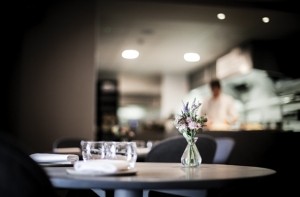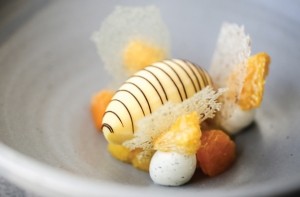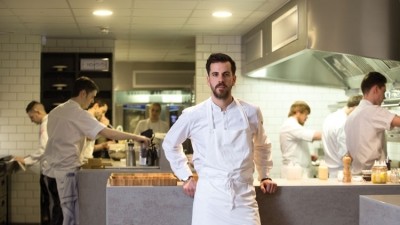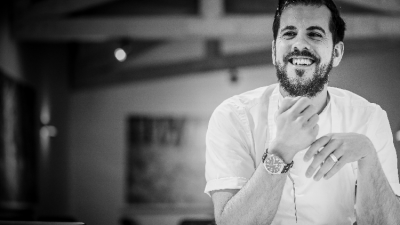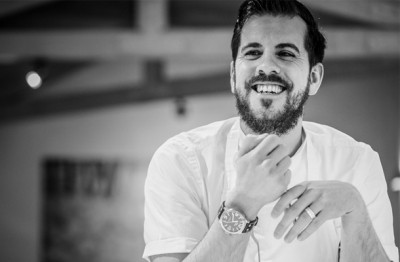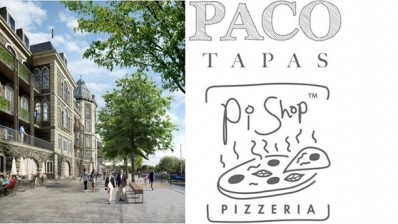Home improvement: Bristol's rebooted Casamia is building on its success
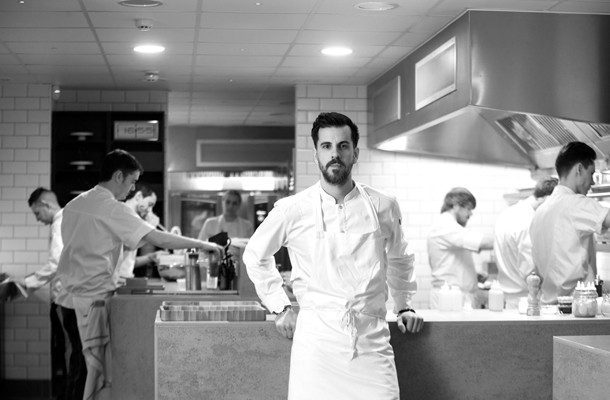
At 3.10pm on Thursday 9 November Peter Sanchez-Iglesias sent a heartbreakingly concise tweet to his followers: “Jonray Luis Sanchez-Iglesias 1983-2015, love u forever bro x”. After four years of silently battling with skin cancer, Sanchez-Iglesias’ older brother and culinary collaborator passed away shortly after the pair announced they would be relocating their much-fêted fine-dining restaurant to central Bristol, with bigger and bolder plans on the horizon.
To lose a sibling is hard enough, but the intensity of the pair’s working relationship and the big plans they had for their business has doubtless made Jonray’s untimely passing even harder to deal with. The brothers had cooked and developed dishes side-by-side at their Westbury-on-Trym restaurant Casamia for 15 years and were rarely seen apart on a professional basis. The restaurant won a Michelin star, among many other plaudits and, in the process, left an indelible mark on the south-west’s food landscape.
Casamia mark two, located at the newly launched The General development in the city, was to mark a new chapter in the pair’s culinary career. Indeed, a new chapter has begun, but not in the way anyone would have wanted it.
It’s a heartbreaking story, but an inspirational one too. To borrow from the vernacular of the professional kitchen, Jonray ‘pushed on’ and, as much as possible, refused to allow his illness to interfere with his work and his life outside the kitchen.
“He was so strong. Jonray never believed he was going to die” says Sanchez-Iglesias of his brother. “He didn’t even make a will. After the initial conversations when he was first diagnosed we never talked about it again. All we wanted to do was enjoy life and cook great food at our restaurant. We valued every single moment together over those four years.”
There were good weeks and bad weeks but, for much of his illness, Jonray was able to be one of the boys in the kitchen at Casamia. Shortly after he found out he had cancer, the brothers made their London debut with a residency at the Electrolux Cube on Southbank.
“Getting the chance to cook together in London was a big moment for us. It was one of the worst points in his illness but he managed to cook lunch and dinner for 14 days on the trot. It was a struggle for him physically and even harder on us both emotionally. He wouldn’t accept any help. At the beginning he said ‘mate, I just want to smash this in’, and that’s what we did.”
What the 30-year-old has achieved since his brother’s death last November is no less of an inspiration. Though supported by his family and his kitchen team, he has borne the bulk of the responsibility for the business on his own shoulders. The fact that the loss of his brother has coincided with a hugely ambitious – and it must be said, rather risky – move from the suburbs to the centre of Bristol makes it even
more remarkable.
Casamia closed on Christmas Eve and reopened at its new location on Bristol’s floating harbour just two weeks later. He admits that being very busy has made the loss of his brother a little easier to cope with.
"It’s stopped my mind from wandering. But when I’m on my own, late at night, and I think about him, it really hurts. I also feel bad for my parents who have had more time to reflect on things. It’s been very hard for them.”
The opening of the new Casamia is the culmination of a decade and a half’s work for the brothers, and jeopardising all that to mourn wasn’t an option. When the inaugural service commenced at the new Casamia on 16 January, no ritual was needed to acknowledge his brother’s absence. “Jonray was there as much as I was. It’s what we’d planned together. When I looked round at the boys enjoying having more space and better equipment, I couldn’t help smiling because it was all exactly as he would have wanted it. Jonray has been so influential in how the kitchen and wider restaurant is run, how it should function and how we should interact with each other,” he says.
Sanchez-Iglesias is comfortable talking about his brother. His voice cracks only once when recalling the early days of the (then) Italian restaurant and the pair’s gradual transition from stretching pizzas and making trays of cannelloni to running one of the country’s most ambitious restaurants.
“I can talk about it, it’s other people who often struggle with it,” he says. “We’re always talking about Jonray in the kitchen because it helps us think about him in a positive way rather than dwell on the illness. The last thing he’d have wanted was to be defined by it.”
From humble beginnings
Casamia was opened in 1997 by the brother’s Spanish father Paco and Bristol-born mother Sue. The brothers worked in the kitchen as teenagers and soon developed a love of and aptitude for Italian cooking. The menu started to shorten, the cooking became more ambitious and the quality of the food increased dramatically.
In 2004, the pair flew the nest to open a restaurant in nearby Cheltenham called Fratelli (Italian for brothers). It reviewed well, but the midweek trade was so slow the restaurant closed after less than a year. Returning to the family restaurant, in 2006 their parents gave them free rein in the kitchen. Soon after, word started to get out about two brothers who were experimenting with techniques that were far removed from an Italian restaurant in a Bristol suburb. At that time, everything was done on a shoestring. A hacked bain-marie stood in for a waterbath and the brothers bodged a meat-ageing fridge by rigging up a domestic fan in an old drinks fridge.
A Michelin-star followed in 2009 and, a year later, the pair got an early taste of the limelight after featuring in and ultimately winning the TV programme Ramsay’s Best Restaurants. The Bristolian brothers instantly charmed Gordon Ramsay with their unusual combo of talent, raw ambition and a humble attitude. Since then they’ve charmed pretty much everyone else, with Casamia listed in all the guides and regularly appearing in the top restaurant rankings.
You couldn’t make up a better back story, and with its beautiful wrought-iron gate, the old Casamia is home to a lot of memories that are made all the more poignant by Jonray’s passing. The restaurant’s lease – 100 per cent owned by the family – has been sold to the people behind well-regarded Bristol pizza restaurant Flour & Ash and will reopen later this year.
“They’ll do brilliantly there. It’s great to have someone decent going in because we care about that site a lot,” says Sánchez-Iglesias, who originally thought the move would be a wrench.
“I thought I’d be really upset and miss the old restaurant, but when we started cooking at the new place, I knew it was where we should be.”
The new Casamia is located in a Grade II-listed building that once housed Bristol’s main hospital and anchors The General, which is a high-end residential development. Developer City & Country approached the brothers about moving their flagship there, but the pair were resistant at first.
“When we were driving down to have a look, Jonray – who was obviously ill at the time – wasn’t into it at all. But when he saw the space and the details I saw his eyes start to light up and he started asking loads of questions. Then we brought dad down and he loved it,” he recalls.
Extending Casamia's reach
From an external perspective the move didn’t appear sensible. The brothers were doing just fine in Westbury-on Trym and the rent was low. Relocation was expensive and it reduced the number of restaurant covers by six. It also seemed to primarily be motivated by a desire to streamline kitchen operations.
Sanchez-Iglesias’ plan to keep the pricing structure identical and reopen in January was another eyebrow-raiser. How was a fine-dining restaurant run on slim margins and open for eight services a week going to make its investment back and cope with a significantly higher rent?
“The business plan was written on the basis that we would be much busier at the new location, and I’m happy to say we have been,” he says, when quizzed on the financial logic of the move. “Opening in January was risky but, as it turned out, we were fully booked for lunch and dinner throughout the month, and February was great too.”
A more central location has made it possible to turn the odd table in the evenings and smooth the flow of orders coming into the kitchen. While the complexity and length of the evening tasting menus precludes a split seating, Casamia is booking people in from as early as 6pm and as late as 9.15pm.
“People thought we were crazy but it’s working. Some are happy to eat early or late if it means they get the booking and pushing tables at these times means we can easily hit 40 covers per evening service, which is what we need to do to make money. The other big benefit is that it creates a much better atmosphere because we tend to have a dozen or so people already sitting down eating by 7pm. At the last place, we were empty at that time.”
The new restaurant is also a statement, and one that, in retrospect, the brothers Sanchez-Iglesias needed to make. The rustic look of the original Casamia had been at odds with the pair’s ambitious cooking for some time.
Housed within arches, the new space is a stunner. Designed by Jonray, the restaurant’s beautiful sign references the old restaurant’s gate and – while understated – hints at the level of care and attention the brothers have lavished on every detail. The whitewashed walls allow the character of the old building to show through and are balanced by more modern touches including polished concrete waiter’s stations and chairs that bring to mind the work of Charles and Ray Eames. It’s a fitting stage for father Paco, who remains Casamia’s maître d’, and can usually be found gliding sprightly across the restaurant’s wooden floorboards.
But the real head-turner is Casamia’s ultra modern open kitchen, which will have even the most well-equipped of brigades drooling into their Thermomix. Within it, serious chefs cook serious food in a near silence, broken only by the occasional bleep of a timer.
A move into mid-market
Casamia’s kitchen may be a statement of intent in terms of premiership-level gastronomy, but the family also has big plans for more affordable dining. During the next few months, Sanchez-Iglesias and his team will open two additional restaurants alongside the flagship, a pizzeria and a tapas restaurant. With the family’s roots in casual eating, the brothers had been planning these more informal offshoots for some time.
“The business started life as an everyday Italian. Jonray and I started our careers making pizza and lasagne, and it’s a style of cooking we were always going to return to. Casamia stopped being a place where you’d pop in for a quick bite a long time ago but we want people that like what we do to have more reasons to visit us. People ask me why I’ve chosen to take so much more on but, in comparison to Casamia, which is stressful, intense and very personal, these are simple businesses to run.”
Opening as early as next month, The Pi Shop will be a stripped-back 60-cover pizzeria serving Naples-style pizza with a West Country twist and not a great deal else save home-made soft-serve ice cream. It will be extremely affordable with pizzas starting at £5.50. “Frankly, some pizza places take the piss with pricing – £9 for a margherita is too high. We’re using much better ingredients than most pizza places and we can afford to sell it for almost half that.”
The Pi Shop will be run along traditional lines but within its DNA will be the Casamia kitchen’s attention to detail, its focus on high-quality ingredients, the majority of which will be sourced from the south-west, and inquisitive nature. As such, there’s recently been a lot of debate in the kitchen over that most controversial of pizza parlour-based double acts, ham and pineapple. “We’re interested in it because all the trendy pizza places refuse to do it despite it being one of the country’s most popular pizza toppings. The flavours work together and we can get great local ham and great pineapple. We don’t see the problem.”
Sanchez-Iglesias and development chef Josh Green have spent months working on a dough recipe, which is made with the same ferment used for Casamia’s brilliant sourdough. However, the pair don’t want to use sourdough in their marketing. “It’s become a bit of a buzzword and we don’t want to make a big song and dance about it. We’ve used the biga (the Italian word for a pre-ferment) because it makes the pizza more digestible.”
The pizzas will be cooked in an enormous clay oven made by a local company that specialises in making tandoors, fired using wood from local apple trees rather than the reconstituted logs favoured by many woodburning pizzerias these days. Like most pizza restaurants, the business will operate seven days a week so the oven never fully cools and the dough-making regime goes on interrupted.
The third restaurant – at least for the moment because Sanchez-Iglesias eventually plans to roll out The Pi Shop – is expected to open a month or so on and will be named after his Andalusian father Paco. Casamia was originally intended to be a Spanish restaurant but with decades of experience in Italian restaurants, Paco opted to open a trattoria.
“He knew it was a proven restaurant formula. Back in 1999, tapas in a Bristol suburb would have been risky. Failure wasn’t an option as everything my parents had went into the old restaurant. My dad was born in Seville and is a great cook so will have a lot of say about what goes on the menu. It’s our job to tweak things and make them even better, although when it comes to things such as tortilla, we won’t muck about because there are some things that can’t be improved on.”
Like The Pi Shop, most of Paco’s produce will come from the south-west but some key ingredients will be sourced from Spain. “I’m committed to seasonality so we won’t be serving tomatoes all year round, which may come as a shock to some. The menu will change every day but they’ll be a core of classic dishes that are always available. English people – myself included – would always expect to be able to order patatas bravas in a tapas place.”
The bulk of the food will be cooked in Paco’s wood-burning oven. The menu is still in the development stage, but Bristolians can expect high-quality meat and fish – perhaps a whole turbot or a leg of lamb – cooked ahead of service to be served in smaller portions.
Two stars in his eyes
The plan is to keep all the existing staff cooking at Casamia, but Green will be heavily involved with both restaurants as they bed in.
The focus for Sanchez-Iglesias, and long-serving head chef Jim Day, will be on the flagship, but the former will be able to monitor what’s going at the other two restaurants. In fact, he can see them both from Casamia’s pass.
And, despite trebling his restaurant business almost overnight, Sanchez-Iglesias believes that this move will enable Casamia to build on its past success and push for a second Michelin star. In fact, the new kitchen’s enhanced structure, better equipment and commensurately better working environment is already having a tangible impact on the quality of Casamia’s food, he says.
“The next step is to try to get two stars. We’re not there at the moment, though.“It’s lovely to think that one day we could get three, but that’s a long way off. It’s good to have goals and also to remember that the chefs that do get three stars are human beings just like us.”
His big brother would be proud.
